Best Single Board Computer Windows 10
Best Single-Board Computers for Every Utilise and Budget in 2021
Always since the introduction of the Raspberry Pi, unmarried-board computers (SBCs) take risen in popularity. While the Raspberry Pi is undoubtedly the most pop maker board on the planet, it'southward far from the only selection. At that place are development boards for a variety of purposes and at a range of prices. From tiny, inexpensive single-board computers to beefy desktop-replacement SBCs, yous'll find a ton of choices. Check out the best single-board computers for all uses and budgets, from x86 SBCs and ARM SBCs to single-lath computers for gaming, cheap dev boards, and more!
What is a Single-Board Estimator?
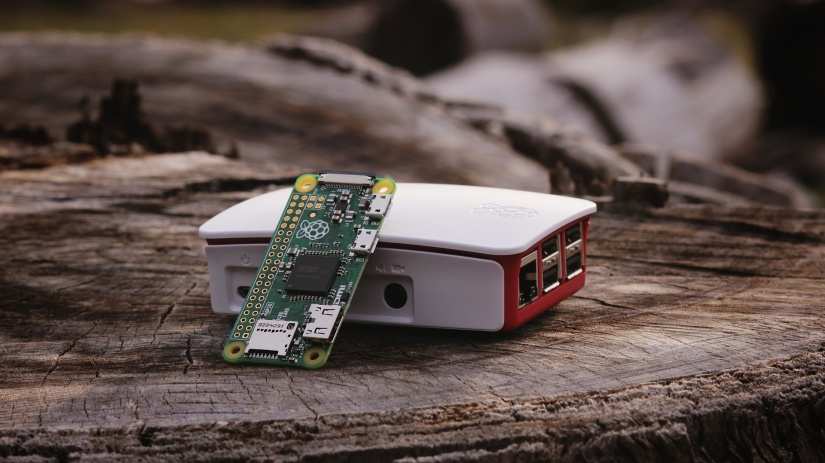
Equally the name suggests, a single-board computer is a device with all of its components such as RAM, a GPU, and CPU baked-in. Compare that to a traditional desktop PC where the motherboard comes sans retentiveness and processors. Furthermore, nigh SBCs characteristic smaller footprints than their desktop counterparts. Still, there'southward definitely variation. Whereas some maker boards go far in credit card-sized form factors, others are decidedly larger.
What is a unmarried-board estimator: A reckoner with all of its essential components such every bit RAM, CPU, and GPU born. Usually, SBCs are small, nearly the size of a credit card, or a bit larger but still smaller than the boilerplate desktop PC.
What Should Yous Look for in an SBC?
When selecting the best top single-board figurer for your needs, you'll want to consider your priorities. Price is definitely a gene, with the cheapest unmarried-board calculator devices clocking in around $five USD, and pricey merely powerful dev boards retailing for several hundred dollars. Size matters, too. You lot might want a tiny maker board for article of clothing tech or a robotics project, or a larger single-board PC for avant-garde, ability-hungry applications.
What you plan to use your maker board for is essential. For basic tasks that don't require much computing power, almost any board will do. But you might need a more capable device for multi-tasking or avant-garde processing. SBC applications range from basic Linux PCs to retro gaming consoles, smart home hubs, domicile servers, and a variety of other employ cases. As as of import, underlying architecture and operating arrangement (Os) compatibility come up into play. You'll need to effigy out what OS, such as Linux, Android, or a not-Linux operating system such as FreeBSD, you'd like to use. Likewise, whether you opt for an x86 or ARM SBC somewhat shapes which OSes you can run. While at that place are tons of
Single-lath figurer purchasing considerations:
- Cost
- Intended utilize
- Size
- Underlying architecture - ARM vs. x86 SBCs
- Desired Bone
What can You lot practise With a Single-Board Calculator?
But what tin a single-board PC actually do? Basically, SBCs can tackle virtually whatsoever task that traditional desktops and laptops can, with a caveat: this heavily depends on what specific processing power y'all're working with. While sure single-board computers include desktop-grade CPU and GPU ability, others are pretty pocket-size. Well-nigh SBCs can handle bones desktop use such every bit web browsing and office productivity. Gaming on maker boards remains a popular pastime, from native Android or Linux gaming to emulation.
With Internet connectivity, Internet of Things (IoT) projects are popular on dev boards. Media and file servers, smart home hubs, VPN servers, whole-home ad-blockers, and a variety of other connected device applications are all possible. With small-scale form-factors and depression-ability depict, SBCs are bang-up for robotics tinkering. And y'all can even utilise maker boards for artificial intelligence (AI) in some cases. Although the majority of SBC OSes are Linux-based, you can find Android as well equally Chrome OS for edifice Android PCs and tablets, or Chrome OS desktops and laptops. The opportunities are nearly endless. In fact, the primary limiting factor isn't what a single-board reckoner tin practise, information technology'southward what a specific SBC can accomplish.
What can you do with a unmarried-board estimator:
- Gaming and retro gaming emulation
- Basic desktop use such as part productivity
- Server utilise - media server, file server, VPN server, 3D printer management server, etc.
- IoT applications - smart abode hub, whole-habitation ad-blocker
- Robotics
- AI
Best Overall Unmarried-board Computer 2021 - Raspberry Pi 4
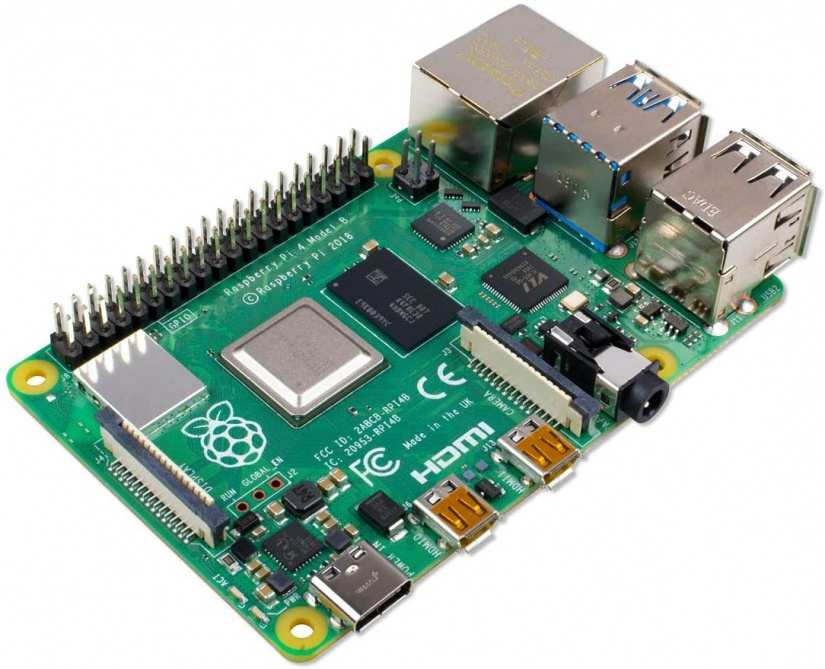
Hailing from the Raspberry Pi Foundation, the Raspberry Pi four reigns supreme equally hands-down the all-time unmarried-board calculator for near users. While more powerful SBCs exist, the price-to-operation ratio of the RasPi four absolutely blows any competition out of the water. With several different models offering a selection of 2GB, 4GB, or 8GB of RAM, and a low starting price of just $35, the Pi 4 is a fantastic trivial credit menu-sized device. What makes information technology particularly accessible for makers of all skill levels is its accessibility and versatility. The Raspberry Pi Foundation offers a slew of official resources from forums tp a Linux-based operating arrangement in Raspberry Pi OS. Additionally, you'll find unrivaled community support with a slew of 3rd-party resources ranging from books, hardware accessories, and OSes to forums, blogs, and subreddits. It's a ridiculously well-supported SBC.
Furthermore, the Raspberry Pi 4 works tremendously well for a smattering of different uses. It's equally cracking as a desktop replacement for writing, editing, paradigm editing, and podcasting as it is for emulation. Y'all tin spin upwards a media server that's actually quite competent, or a cheap file server alternative to off-the-shelf network-attached storage (NAS) device. Smart abode hubs, 3D impress management servers, and habitation theatre PCs (HTPCs) with the likes of Kodi all work wonderfully. Admittedly, the Raspberry Pi 4, despite its capabilities, isn't capable of some tasks. Although you can stream PC games to the Pi using Steam Link, information technology's not going to be able to natively run modern computer games. And since a media server is heavily CPU-intensive, the Pi can't handle video transcoding. But the price is right, it's incredibly well-documented, and the Pi doesn't shy away from a bunch of tasks. Whether you desire to run Linux, a game with RetroPie, make a robot automobile or mess with AI, the Pi tin can exercise it all with superb grace.
Pros:
- Versatile
- Affordable
- Several different RAM options
- Easy to utilize
- First-class price-to-operation ratio
- Pocket-sized footprint
- Low power draw
- Great Bone compatibility - Linux, Android, Chrome Os, not-Linux OSes
Cons:
- Not a truthful desktop replacement
- More powerful SBCs bachelor
Raspberry Pi 4 specs:
- Broadcom BCM2711, Quad-core Cortex-A72 (ARM v8) 64-chip SoC @ 1.5GHz
- 1GB, 2GB, 4GB, or 8GB LPDDR4-2400 SDRAM (depending on model)
- 2.4 GHz and 5.0 GHz IEEE 802.11ac wireless, Bluetooth 5.0, BLE
- Gigabit Ethernet
- 2 USB 3.0 ports; two USB ii.0 ports.
- Raspberry Pi standard 40 pin GPIO header (fully backwards compatible with previous boards)
- ii × micro-HDMI ports (upwardly to 4kp60 supported)
- 2-lane MIPI DSI display port
- ii-lane MIPI CSI camera port
- 4-pole stereo audio and composite video port
- H.265 (4kp60 decode), H264 (1080p60 decode, 1080p30 encode)
- OpenGL ES 3.0 graphics
- MicroSD menu slot for loading operating system and information storage
- 5V DC via USB-C connector (minimum 3A*)
- 5V DC via GPIO header (minimum 3A*)
- Ability over Ethernet (PoE) enabled (requires separate PoE HAT)
- Operating temperature: 0 – fifty degrees C ambient
Nigh Powerful Single-lath Computer 2021 - UDOO Commodities
If y'all're looking for a true desktop and laptop replacement, the UDOO Bolt stands out as the nearly powerful single-lath figurer in 2021. Its footprint is larger than that of the Raspberry Pi and other small SBCs. Similarly, whereas many dev boards are ARM-based, the UDOO Bolt is an x86 SBC. As such, it'due south a Windows 10-capable single-board computer. And the Commodities runs Linux distributions such equally Ubuntu and Debian with ease.
You'll find two dissimilar variants of the Udoo Bolt: the V3 and V8. Featuring AMD Ryzen embedded engineering, the UDOO Commodities V3 rocks a Ryzen V1202B dual-core, four-thread CPU clocked at two.3GHz with a three.2GHz boost, and AMD Radeon Vega 3 graphics. Stride up to the V8 for a Ryzen embedded V1605B quad-core, viii-thread processor at 2GHz with a 3.6GHz boost and Radeon Vega eight graphics. The course gene is larger than that of the Pi 4, and comparable to an Intel NUC mini PC. Civilities such as So-DIMM 64-chip DDR4 RAM up to 32GB, SATA, and 32GB of eMMC storage makes the Bolt brute. It'southward a true desktop replacement capable of playing modern AAA titles and emulating consoles such as the PlayStation 3 and Wii U. Of class, all of this awesomeness comes at a price - quite literally. The UDOO Bolt V3 retails for over $300, and the V8 has an over $400 pricetag. That'due south non cheap, but with functioning almost double that of an Apple MacBook Pro 13", it's a bulky piffling reckoner. For a solid x86 single-board computer that can run Windows, Linux, and high-cease applications, this SBC with SATA is an bodily desktop replacement.
Pros:
- x86 single-lath computer
- Runs Windows 10 as well as x86 Linux distros
- Ii versions, the V3 and V8 both with AMD Ryzen embedded processors
- AMD Radeon Vega 3 and Vega eight graphics
- Tin can handle high-end emulation and mod AAA gaming
- SATA onboard
- Upward to 32GB of DDR4 RAM
Cons:
- Expensive
- Larger than virtually SBCs like the Raspberry Pi
Udoo Bolt specs:
- AMD Ryzen Embedded V1000 with Microchip Atmega32U4 MCU: V1202B — 2x (4x thread) Ryzen cores @ two.3GHz/3.2GHz boost with Radeon Vega three, or Microchip Atmega32U4 MCU V1605B quad-cadre, (8x thread) Ryzen cores @ 2.0GHz/3.6GHz heave with Radeon Vega 8 graphics
- Memory/storage: 0GB, 4GB, 8GB, or 16GB DDR4-2400 RAM with ECC support via 2x sockets (supports up to 32GB)
- 32GB eMMC v.0
- M.2 B-Key 2260 for SSDs (also supports PCIe x2)
- M.2 G-Key 2280 for NVME storage modules (also supports PCIe Gen iii x4)
- SATA Iii connector with SATA power
- 802.11ac and Bluetooth 4.0
- Gigabit Ethernet port
- Dual HDMI 2.0a ports, dual DisplayPorts available through dual-office USB 3.0 Type-C ports
- iv x simultaneous 4K@60 displays
- Radeon Vega 3 or 8 graphics with DirectX 12, OpenGL, and Vulkan support; H.265 decode and (8-bit) encode, VP9 decode
- Headphone/mic combo jack
- 2 x USB three.1 ports
- 2 x USB three.0 Blazon-C
- Arduino-compatible MCU I/O:Up to 26x digital I/O (includes upwardly to 7x PWM)
Cheapest Single-Board Computer - Raspberry Pi Zero and Raspberry Pi Zero W
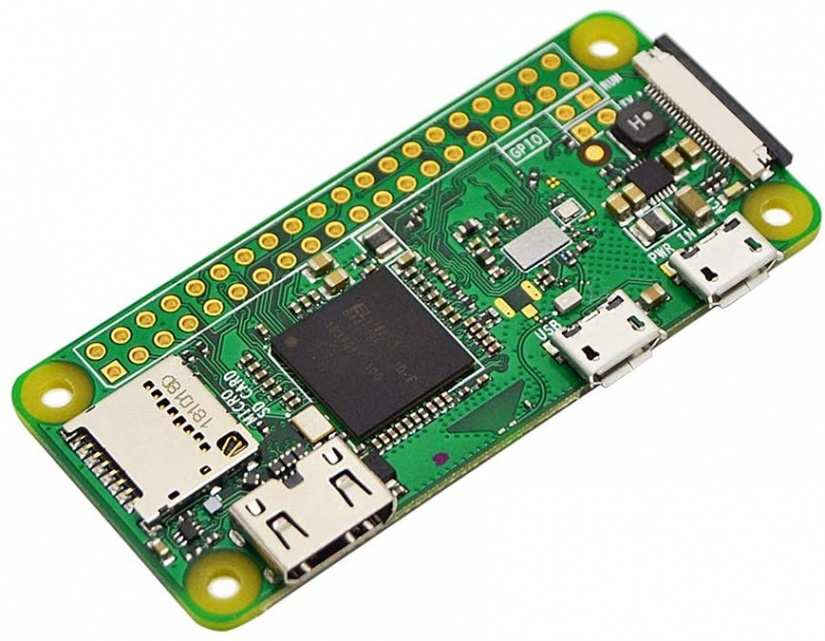
At a absurd $5 and $10 respectively, the Raspberry Pi Zippo and Aught W are the cheapest unmarried-board computers bachelor. For less than the price of Netflix each calendar month, yous can buy a utilitarian SBC perfect for IoT applications. Its 65mm x xxx mm x 5mm footprint is tiny, then information technology's 1 of the smallest maker boards you can detect. As such, integration into free energy-efficient projects is top-notch. Yous can build robots, smart habitation security cameras, and a bunch of other low-power gadgets with a RasPi 0 and Raspberry Pi 0 W. You can fifty-fifty brand a practice-it-yourself (DIY) portable handheld retro games console using kits like the RetroFlag GPi.
Whereas the vanilla RasPi 0 lacks Bluetooth and Wi-Fi, the Pi 0 W (Westward for wireless) tacks on both 802.11b/g/n Wi-Fi and Bluetooth 4.1 BLE. Despite a minuscule size, the Raspberry Pi 0 and 0 West stone USB ports, sound jacks, and microSD connectivity aslope 512MB RAM and a 1GHz single-core CPU. You can even solder on a GPIO header for connectivity with accessories like Pi HATs. Overall, the Raspberry Pi Null and Zero Westward are good cheap single-board computers.
Pros:
- Affordable
- Modest size
- Swell for robotics, wearables, etc.
- Well-documented with a massive community
- Lots of offset- and third-party resource
- Runs Linux well
- Good connectivity - USB, microSD, audio jack
- 1GHz single-core CPU, 512MB RAM
- Wi-Fi and Bluetooth on Pi Zero W
- Available GPIO header tin be soldered on
Cons:
- Pi Zip lacks Wi-Fi and Bluetooth
- GPIO header must be soldered on
Raspberry Pi Nada specs:
- 65mm × 30mm × 5mm
- SoC: Broadcom BCM28351GHz, single-cadre CPU
- 512MB RAM
- Mini HDMI and USB On-The-Get ports
- Micro USB power
- Lid-compatible forty-pivot header
- Composite video and reset headers
- CSI photographic camera connector
Pi Zero W (same every bit Pi Zero plus):
- 802.11 b/g/north wireless LAN
- Bluetooth 4.1, Bluetooth Low Energy (BLE)
Best ARM SBC for AI, Robotics, PC Utilise, and More - Nvidia Jetson Xavier NX
There's not much the Nvidia Jetson Xavier NX can't handle. With its beefy Nvidia Volta GPU, the Nvidia Jetson Xavier NX is an AI-capable development board. Powered by a 384-cadre Nvidia Volta GPU, the Jetson Xavier NX boasts a half dozen-core ARMv8.ii CPU. You'll find 8GB of 128-bit LPDDR4, a 16GB eMMC module, and dual Nvidia Deep Learning Accelerator engines. It'south capable of pumping out 4K video with its dual DisplayPort/HDMI outputs, and features first-class inputs/outputs (I/O) ranging from USB iii.1 to GPIO.
With a whopping 48 Tensor Cores and an impressive 21 TOPS of computer power under 15W and fourteen TOPS of compute nether 10W, the Nvidia Jetson Nano is the best ARM SBC for a variety of purposes. It runs AI applications such every bit machine learning with equal grace equally robotics, desktop use, and even retro gaming. If you need an ARM single-board computer that won't shy away from anything, the Jetson Xavier NX is easily the winner. Alternatively, the slightly less powerful although still capable Nvidia Jetson Nano sports a quad-cadre ARM A57 CPU, 128-core Nvidia Maxwell GPU, and 4GB of DDR4.
Pros:
- AI-capable - handles machine learning, natural linguistic communication processing, and more
- Groovy for robotics
- Excellent for desktop use
- Fantastic for high-end retro gaming emulation
- Swell I/O - Wi-Fi, Bluetooth, USB iii.i, GPIO, HDMI/DisplayPort
- Upward to 21 TOPS of computer power
- 4K video output
- Minor course factor
Cons:
- Expensive
- Larger than Raspberry Pi and its alternatives
Nvidia Jetson Xavier NX specs:
- CPU: 6-core NVIDIA Carmel 64-bit ARMv8.2 @ 1400MHz* (6MB L2 + 4MB L3)
- GPU: 384-core NVIDIA Volta @ 1100MHz with 48 Tensor Cores
- Dual NVIDIA Deep Learning Accelerator (NVDLA) engines
- 8GB 128-bit LPDDR4x @ 1600MHz | 51.2GB/s
- 16GB eMMC
- two x DisplayPort 1.4, eDP ane.4, HDMI 2.0 @4Kp60
- 10/100/thou BASE-T Ethernet
- USB 3.ane, 3 x USB ii.0
Best Upkeep SBC for AI - Nvidia Jetson Nano
The Nvidia Jetson Nano is an incredibly price-constructive maker board that'southward capable of artificial intelligence applications. It'south powered by a 128 CUDA-core Nvidia Maxwell GPU that's paired with a quad-core ARM A57 CPU. Nvidia offers its Jetson Nano with either 2GB or 4GB of DDR4 RAM. The 2GB variant is nearly-identical to the 4GB unit, but y'all'll find a DisplayPort and HDMI, two CSI camera connectors, an K.ii slot, and an extra USB port on the 4GB Jetson Nano. Where the Nano excels is at providing a depression-cost entry signal to at-home robotics and AI projects like machine learning. Although the Nvidia Jetson Nano is a solid board, its CPU isn't the strongest. In fact, the Raspberry Pi 4'southward processor is faster. Still, the Jetson Nano's GPU blows other SBCs out of the water. For motorcar learning and AI on cheaper dev boards similar the Pi 4, y'all'll need to invest in an AI accelerator, whereas the Jetson Nano has everything you demand for artificial intelligence processing born. Its ARM CPU somewhat limits operating system support. Only overall, the Nvidia Jetson Nano is the best budget SBC for AI and robotics. [Read: Nvidia Jetson Nano 2GB Review]
Pros:
- Affordable
- Great for AI, robotics, and more than
- 128 CUDA cores
- Powerful ARM A57 CPU
- 4K video output capabilities
- Runs Linux for Tegra
Cons:
- CPU is less powerful than the Raspberry Pi 4
- Limited Bone support
Nvidia Jetson Nano 4GB specs:
- CPU: Quad-core ARM® Cortex-A57 MPCore processor
- GPU: Nvidia Maxwell™ architecture with 128 Nvidia CUDA cores
- RAM: 4 GB 64-bit LPDDR4
- Storage: 16 GB eMMC five.ane Wink, microSD bill of fare reader
- Video: 4k @ 30fps encoding, 4k @ 60fps decoding
- Camera: 12 lanes (3×4 or 4×2) MIPI CSI-2 DPHY 1.1 (1.5 Gbps)
- Connectivity: Gigabit Ethernet
- Brandish: HDMI 2.0 or DP1.2 | eDP i.4 | DSI (one x2) ii simultaneous
- PCIE/USB: 1 x1/2/4 PCIE, 1x USB three.0, 3x USB 2.0
- I/O: 1x SDIO / 2x SPI / 6x I2C / 2x I2S / GPIOs
- Dimensions: 69.six mm 10 45 mm
Baseboard:
- USB: 4x USB iii.0, USB 2.0 Micro-B
- Photographic camera: 1x MIPI CSI-ii DPHY lanes (Raspberry Pi photographic camera compatible)
- LAN: Gigabit Ethernet, M.two Fundamental Eastward
- Display: HDMI 2.0 and eDP 1.4
- Other I/O: GPIO, I2C, I2S, SPI, UART
- Power: 5v via microSD or barrel jack.
NVIDIA Jetson Nano 2GB specs:
- GPU: 128-core NVIDIA Maxwell™ architecture-based GPU
- CPU: Quad-cadre ARM® A57
- Video: 4K @ xxx fps (H.264/H.265) / 4K @ threescore fps (H.264/H.265) encode and decode
- Camera: MIPI CSI-ii DPHY lanes, 12x (Module) and 1x (Developer Kit)
- Retentiveness: 2GB 64-scrap LPDDR4; 25.six gigabytes/second
- Connectivity: Gigabit Ethernet
- OS Back up: Linux for Tegra®
- Module Size: 70mm x 45mm
- Developer Kit Size: 100mm x 80mm
Jetson Nano Baseboard specs:
- USB: 3x USB (2x 2.0, 1x 3.0), USB 2.0 Micro-B
- Camera: 1x MIPI CSI-2 DPHY lanes (Raspberry Pi camera compatible)
- LAN: Gigabit Ethernet
- Display: HDMI 2.0
- Other I/O: GPIO, I2C, I2S, SPI, UART
- Ability: 5v via USB-C
Best Single Board PC for Android - Odroid N2
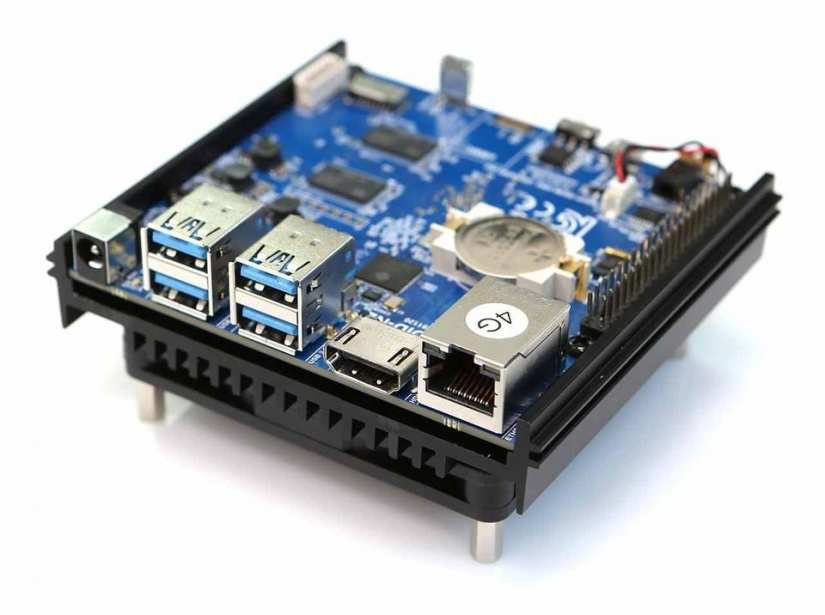
While there are boatloads of non-Linux OSes similar the Chrome OS (despite technically using the Linux kernel. Chrome Bone doesn't resemble full-fledged Linux distros), FreeBSD, and OpenBSD for SBCs, not many maker boards run Anrdoid well. Even though Android images for the Raspberry Pi exist, functionality isn't great. But the Odroid N2 and the Odroid XU4 are the height SBCs for Android. Despite lacking an official paradigm, the Odroid N2 offers a polished Android epitome. Similarly, the Odroid XU4 boasts a expert Android image as well. If you're looking for a single-lath that can run Android, check out Odroid.
Pros:
- Powerful
- Runs Linux and Android well
- Great community back up
- 2GB or 4GB RAM
- 4K video output
- Amlogic S922X quad-cadre Cortex-A73 @one.8GHz, dual-core Cortex-A53 @ one.9GHz
- First-class I/O - 4 x USB 3.0, USB ii.0, HDMI, micro USB, Gigabit Ethernet
Cons:
- No Wi-Fi or Bluetooth
Odroid N2 specs:
- Amlogic S922X (4x Cortex-A73 @ 1.8GHz, 2x Cortex-A53 @ i.9GHz); 12nm fab; Mali-G52 GPU with 6x 846MHz EEs
- 2GB or 4GB DDR4 (1320MHz, 2640MT/s) 32-bit RAM
- Gigabit Ethernet
- HDMI 2.1 up to 4K @60Hz with HDR and CEC
- Composite video out jack
- SPDIF
- four x USB 3.0, micro USB 2.0 with OTG
- 40-pivot GPIO header
- Compatible with Linux, Android, and more
Buy from Ameridroid
All-time Raspberry Pi Culling - Stone Pi 4
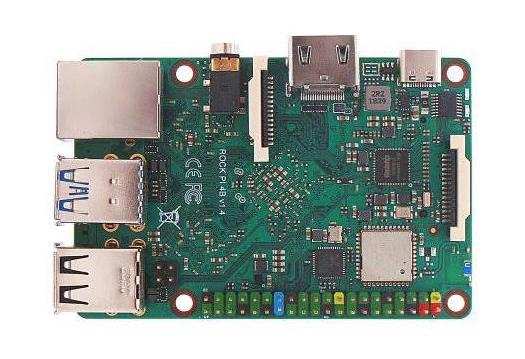
Don't be fooled by its class gene and name. Indeed, the Stone Pi 4 arrives in almost the exact same size and shape of the Raspberry Pi 4. But its more than powerful CPU and GPU coupled with a dedicated AI stack consummate with GPU acceleration makes the Rock Pi 4 a amend value than the Raspberry Pi four. And where many SBCs falter, the Stone Pi 4 shines: support. You'll discover loads of uniform Linux distros and fifty-fifty an official Android OS. Unfortunately, it's pricier than the Raspberry Pi 4, but if yous need the performance boost, the Stone Pi 4 is the best Raspberry Pi 4 alternative on the marketplace.
Pros:
- Dedicated AI stack with GPU acceleration
- Keen OS support - Linux and Android
- Faster CPU and GPU than the RasPi four
Cons:
- Pricier than the Pi 4
Rock Pi 4 specs:
- CPU: Rockchip RK3399 dual Cortex-A72, @ ane.8Ghz, quad-cadre Cortex-A53 @ 1.4Ghz
- GPU: Mali T860MP4 GPU with back up for OpenGL ES 1.1 /2.0 /3.0 /three.1 /three.2, Vulkan 1.0, Open CL 1.1 1.2, DX11
- 1GB, 2GB, or 4GB of 64-bit dual-channel LPDDR4 RAM
- 40-pin GPIUO header
- eMMC module
- M.ii SSD connector
- HDMI ii.0 up to 4K@60
- MIPI DSI
- 2.5mm jack
- MIPI CSI
- 802.11 air conditioning Wi-Fi, Bluetooth five.0
- USB iii.0 with OTG, USB 2.0
- Gigabit LAN
Best Raspberry Pi 3 B+ Alternative - ASUS Tinker Board and Tinker Lath S
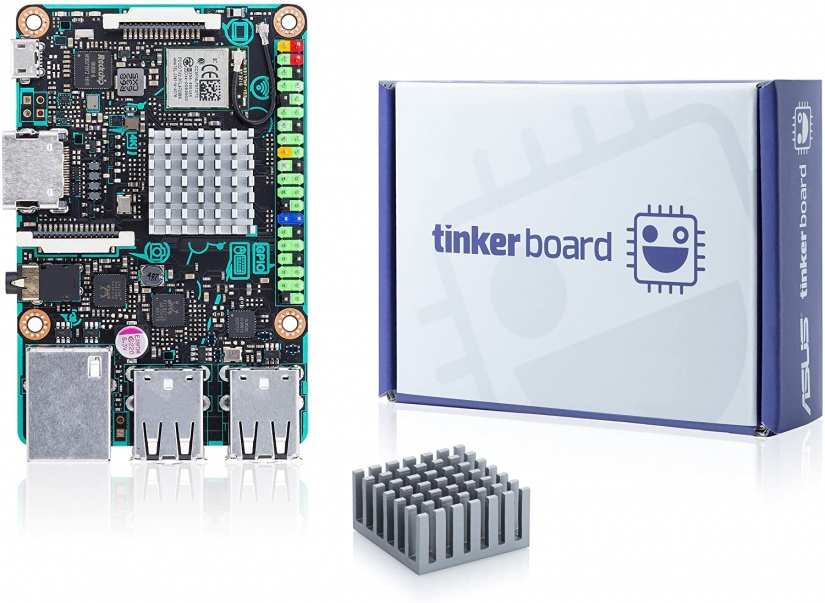
When it comes to single-board computers, the Raspberry Pi trounces the contest. Aside from desktop-quotient dev boards like the Udoo Bolt and Nvidia Jetson Nano, for credit carte du jour-sized SBCs under $100 USD, the Pi 4 is without a uncertainty your best option. Withal, there are some worthy contenders. The ASUS Tinker Board and Tinker Lath S both deliver similar operation in a similar package. Sporting the same form factor as the Raspberry Pi 2, iii, and 3 B+, the Tinker Lath retains compatibility with RasPi accessories such every bit cases and GPIO add together-ons. Moreover, ASUS supports its device incredibly well with official Linux and Android images. With 4K video output and its RK3288 organisation-on-a-chip, the ASUS Tinker Board is the top Raspberry Pi alternative available.
Pros:
- Same footprint every bit the Raspberry Pi 3 B+
- Affordable
- 4K video output
- Great I/O
- Wi-Fi and Bluetooth
- GPIO header
Cons:
- Not as powerful as the Raspberry Pi iv
ASUS Tinker Board specs:
- CPU Rockchip RK3288 Cortex-A17 quad-cadre SoC
- GPU: ARM Republic of mali-T764 GPU
- Up to 4K video support
- 2GB DDR3
- 802.11 b/g/n Wi-Fi
- Bluetooth 4.0
- 4 ten USB 2.0 ports
- 15-pin MIPI CSI slot
- 40-pin GPIO header
- micro USB port for power
ASUS Tinker Lath S (aforementioned as ASUS Tinker Lath plus):
- 16GB eMMC
- HDMI-CEC
- Depression-voltage input detection
- Plug-in detection, sound machine-switching
All-time SBC for Automobile Learning - Google Coral Dev Board
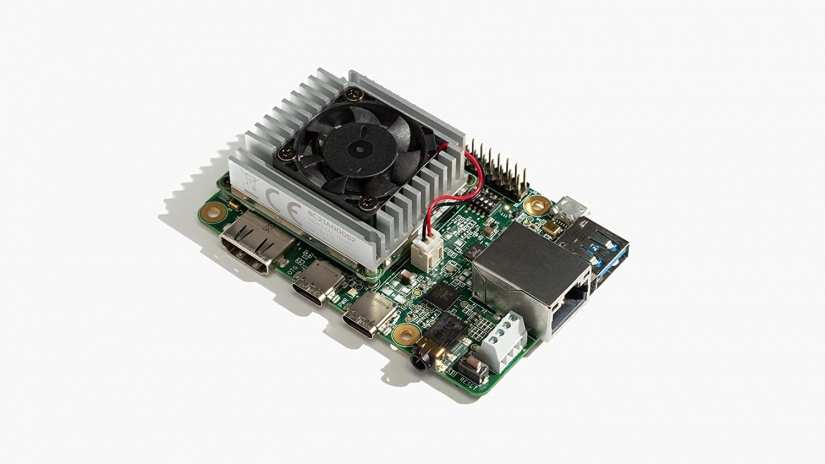
The Google Coral Dev Board is 1 of the best SBCs for AI, and more than specifically it's an excellent maker lath for machine learning. Engineered for utilize with Google's TensorFlow, the Google Coral can run the TensorFlow Lite neural network with ease. Its Edge TPU provides ample ability for machine learning, and the NXP i.MX 8M quad-core Cortex-A53 system-on-a-chip boasts enough of power for artificial intelligence. Still, it'south costly and doesn't work well for desktop use. Yous could instead use a Raspberry Pi iv and the TensorFlow module addition, or simply choice upwards the UDOO Bolt, Nvidia Jetson Nano, or Xavier NX. But if you desire a single-lath computer that can run on-device machine learning with TensorFlow Lite, the Google Coral Dev Lath is a slap-up option.
Pros:
- On-device auto learning with Edge TPU
- Powerful quad-cadre Cortex A-53 SoC
- 1GB DDR4
Cons:
- Expensive
- Not capable of desktop employ
Google Coral Dev Board specs:
- CPU: NXP i.MX 8M SOC (quad Cortex-A53, Cortex-M4F)
- GPU: Integrated GC7000 Lite Graphics
- Onboard Google Edge TPU
- 1GB LPDDR4
The Fastest Single-Board Estimator - ODYSSEY X86J4105800
For the fastest single-board reckoner, and an SBC that tin can run Windows 10, check out the Odyssey X86J4105800. Powered past an Intel Celeron J4105, its quad-core CPU is clocked at 1.5GHz with a ii.5GHz flare-up. There'south an impressive 8GB of LPDDR4 RAM, a 64GB eMMC module, Wi-Fi, Bluetooth BLE, Gigabit Ethernet, and more. Additionally, the Odyssey X86J4105800 comes with an Arduino co-processor built-in for compatibility with Arduino accessories such as sensors and modules. Information technology's a powerful device with an Intel CPU. Disappointingly, its GPU isn't all that beefy, but the X86J4105800 even so performs admirably.
Pros:
- Powerful CPU
- First-class connectivity
- Arduino co-processor onboard
- Intel Celeron CPU
- Runs Windows 10
Cons:
- Not the well-nigh powerful GPU
- Pricey
Odyssey X86J4105800 specs:
- CPU: Intel Celeron J4105 @ @ 1.5–ii.5GHz
- GPU: Intel UHD Graphics 600 @ 250–750MHz
- Co-processor Microchip ATSAMD21G18 32-Fleck ARM-Cortex M0+
- LPDDR4 8GB
- Wi-Fi
- Bluetooth
- 64Gb eMMC (optional)
All-time Budget Single-lath Estimator for AI - Stone Pi N10
At its core, the Stone Pi N10 boasts a robust RK3399Pro that includes an onboard NPU (neural processing unit) for artificial intelligence applications such every bit deep learning. Coupled with its 4GB, 6GB, or 8GB of LPDDR3 RAM and a 16GB eMMC module, the Stone Pi N10 is a good SBC for AI. Yous'll too find a microSD card slot, M.2 SSD connector, and back up for a wide variety of operating systems including Debian Linux OSes and Android. And information technology's accommodating $100. Unfortunately, you won't find Bluetooth or Wi-Fi built-in, although at that place is an optional module for wireless connectivity. With 3.0 TOPS of computing power and its dedicated NPU, the Rock Pi N10 is a solid budget artificial intelligence-capable SBC.
Pros:
- Defended NPU with 3.0 TOPS
- Upwardly to 8GB of DDR3
- Powerful RK3399Pro and Mali T860MP4
- 16GB of eMMC
- Chiliad.2 SSD connector
- Total-size HDMI with 4K@60 back up
Cons:
- Simply DDR3, not DDR4
- No built-in Wi-Fi or Bluetooth
Rock Pi N10 specs:
- CPU: RK3399Pro dual Cortex-A72, frequency 1.8GHz with quad Cortex-A53, frequency 1.4GHz
- GPU: Mali T860MP4 GPU, OpenGL ES 1.i /2.0 /iii.0 /3.i /three.2, Vulkan one.0, Open CL i.1 ane.two, DX1\
- NPU with 3.0 TOPS of compute ability
- Up to 8GB of 64-bit dual-channel LPDDR3@1866Mb/south, 3GB for CPU/GPU, 1GB for NPU
- 16GB eMMC module, microSD card slot, M.2 SSD connector
- FUll-size HDMI 2.0 with 4K@sixty support
- MIPI DSI 2-lane connector
- 3.5mm sound jack
- MIPI CSI ii-lane connector
- 1 x USB 3.0 OTG, ii ten USB 2.0
- Gigabit LAN Ethernet port, optional Wi-Fi and Bluetooth module
- 40-pivot GPIO header
Best SBC for Gaming - RockPro64
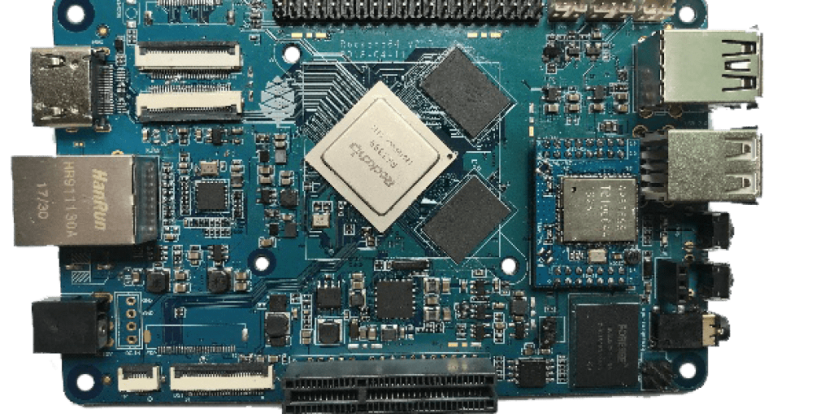
The RockPro64 is a fantastic fiddling device. Powered by an RK3399 with dual ARM Cortex-A72 CPU cores and quad Cortex-A53 cores alongside a Republic of mali-T860MP4 GPU, this board from Pine64 is a fauna. It's bachelor with 2GB or 4GB of LPDDR4 RAM and utilizes either a microSD card or eMMC module. There's a PCIe x4 slot, corking connectivity including USB, DisplayPort, and HDMI. While the RockPro64 lacks built-in Wi-Fi and Bluetooth, there'southward an optional module, and it does pack Gigabit Ethernet. It's reasonably priced at under $100. At that place's a Roshambo retro gaming case available for a SNES aesthetic, or you lot could apply the RockPro64 as a NAS device. Powerful only meaty, the Pine64 RockPro64 is a great ARM SBC for all sorts of maker projects.
Pros:
- Great for gaming
- Powerful CPU and GPU combo
- DDR4 RAM up to 4GB
- xl-pin GPIO header
- PCIe x4 slot
- Gigabit Ethernet
- eMMC and microSD
Cons:
- No Bluetooth or Wi-Fi - available separate module
RockPro64 specs:
- CPU: Rockchip RK3399 Hexa-Core (dual ARM Cortex A72 and quad ARM Cortex A53) 64-Bit Processor and CPU: Mali T860MP4 Quad-Core GPU
- 2GB or 4GB LPDDR4 RAM
- PCIe x4 open up-ended slot
- eMMCmodule and microSD card slot
- one ten USB iii.0Type-C Host with DisplayPort 1.two, 1 ten USB 3.0 type A host, two x USB 2.0 Host
- Gigabit Ethernet
- PI-2 GPIO Double-decker
- 1 x HDMI ii.0 port
- MIPI DSI interface, eDP and Touch Panel interfaces, stereo MIPI CSI interface
Buy from Ameridroid
Best Single-board Reckoner 2021 for All Uses and Budgets - Final Thoughts
Ultimately, there's no shortage of unmarried-lath computers to buy in 2021. From budget-conscious options such every bit the Raspberry Pi Nix and Zero W to desktop-replacement SBCs like the UDOO Bolt and Nvidia Xavier NX, you lot've got a ton of choice. For the bulk of makers, a Raspberry Pi iv is the right selection. It's reasonably-priced, incredibly well-supported, and can handle everything from IoT projects to desktop use and retro gaming with impeccable elegance. If yous need to run AI, the Nvidia Xavier NX, UDOO Bolt, and Odyssey X86J4105800 are all solid. The Odroid N2 and XU4 run Android best, with the ASUS Tinker Lath as a shut contender. And if you need a Raspberry Pi culling, the Stone Pi four is a nifty SBC.
View our range of single board computers available in our store.
Your plough: Which SBCs for 2021 do You recommend?
Source: https://www.electromaker.io/blog/article/best-single-board-computers
Posted by: palmerstrinter.blogspot.com


0 Response to "Best Single Board Computer Windows 10"
Post a Comment